Using Machine Learning Technologies to Design Modular Buildings
Abstract
:1. Introduction
- -
- Analysis of the stress–strain state, design, and optimization of modular building blocks as a whole (1);
- -
- Research and improvement of nodal connections in modules subjected to different types of loads (lateral, seismic, impact, etc.) (2);
- -
- Evaluation of the resistance of modular buildings and individual blocks to progressive collapse triggered by emergency loads and effects causing the inability of individual nodes or structural elements to resist loads (3);
- -
- New materials in modular construction (4);
- -
- Development and improvement of assembly technologies and introduction of new types of modular buildings (5).
2. Methods and Materials
2.1. Problem Statement
2.1.1. A Geometric and Physical Model of a Modular Block Designed for a Gas Compressor at a Gas Turbine Power Plant
2.1.2. Criteria of Limit State for Elements
- -
- Serviceability loss of a structure (I);
- -
- Strength loss of structural elements (II);
- -
- Stability loss of a corrugated web (III).
- -
- Training data are labeled to identify the points belonging to segments , , of the stress–strain curve (see Figure 4a). The creation of arrays of point numbers between the knees of segments ; ; will suffice for this purpose.
- -
- Conditions should be checked and a conclusion should be made in accordance with Table 1 when a test set or a projection is made for the characteristic point .
| The Antecedent: Input Data | The Consequent: The Limit State |
|---|---|
| No limit state; serviceability | |
| Loss of strength or local loss of stability | |
| Loss of serviceability or local loss of stability with displacement restraints | |
| Loss of overall stability or loss of strength | |
2.2. Finite Element Modeling of a Structure
2.2.1. Finite Element Mesh, Loading, and Supports
2.2.2. Description of the Structural Analysis Method
2.3. Machine Learning Models
2.3.1. Making Regression Equations and Adapting Them for Modular Blocks
- -
- Making a linear regression equation.
- -
- Selecting the most effective metric to evaluate the accuracy of predictions.
- -
- Making a numerical model of a facility. In this case, the level of detail in a computational model and the modeling of various nonlinear effects should be taken into account. If the results of numerical modeling show strong nonlinear effects, the basic regression equation should be reconsidered and a higher-order polynomial should be chosen instead of a linear equation.
- -
- Making training and test sets. The size of the training set equals 70% of the total amount of data; the remaining data can be used for cross-validation on the test set.
- -
- Using selected metrics for the accurate evaluation of model predictions.
2.3.2. Piecewise Linear Decomposition
2.3.3. Development of Tree-Based Ensemble Methods
3. Results
3.1. Algorithm of Data Preparation for Machine Learning
- -
- Making sets of corrugated web thicknesses (see Figure 9, Table 2) for which training data must be obtained. It is reasonable to use standard thickness products manufactured by metal smelters. The following thicknesses are taken as a set of available values in accordance with the standards, in mm: Other design parameters can be adopted considering the structural requirements and design experience of the modular constructions under consideration.
- -
- Making a computation in a physically nonlinear formulation and extracting data at each pre-set loading step (forming the set on Figure 9) for each thickness value in question, or selecting a limit state hazard factor, for example, von Mises strain values or their scaled values . Scaling is sometimes necessary to reduce the absolute values of weights in regression equations. The criteria for reaching the limit state are taken from Table 1. In this case, if the operational requirements assume that the system deforms elastically, von Mises stress values or deflection values can be used.
- -
- Sorting load values in the ascending order according to loading stages; selecting and filling the matrix ; and checking the existence of the inverse matrix and the strength of its causation using an infinite norm required for a stable solution to the system of the equation (Equation (10)).
- -
- Performing the transformations (Equation (10)) to obtain the weight coefficients and formulating Equation (12) consisting of the equations for the points (Equation (11)).
- -
- Generating a sample and validating the ensemble model using Expression (13) or other known quality metrics.
| № | kN | Strain | kN | Strain | kN | Strain | |||
|---|---|---|---|---|---|---|---|---|---|
| mm | mm | mm | |||||||
| 1 | 100 | 2.98 × 10−5 | 5.967928 | 100 | 3.05 × 10−5 | 6.108622 | 100 | 3.14 × 10−5 | 6.276434 |
| 2 | 200 | 5.96 × 10−5 | 11.92611 | 200 | 6.1 × 10−5 | 12.20766 | 200 | 6.27 × 10−5 | 12.54381 |
| 3 | 300 | 8.94 × 10−5 | 17.87428 | 300 | 9.15 × 10−5 | 18.29604 | 300 | 9.4 × 10−5 | 18.80007 |
| 4 | 400 | 0.000119 | 23.81122 | 400 | 0.000122 | 24.37342 | 400 | 0.000125 | 25.0453 |
| 5 | 500 | 0.000149 | 29.73724 | 500 | 0.000152 | 30.43934 | 500 | 0.000156 | 31.27862 |
| 6 | 600 | 0.000178 | 35.65146 | 600 | 0.000182 | 36.49368 | 600 | 0.000188 | 37.50006 |
| 7 | 700 | 0.000208 | 41.55344 | 700 | 0.000213 | 42.53462 | 700 | 0.000219 | 43.70862 |
| 8 | 800 | 0.000237 | 47.44258 | 800 | 0.000243 | 48.56278 | 800 | 0.00025 | 49.90342 |
| 9 | 900 | 0.000267 | 53.31846 | 900 | 0.000273 | 54.57748 | 900 | 0.00028 | 56.08418 |
| 10 | 1000 | 0.000296 | 59.18018 | 1000 | 0.000303 | 60.57726 | 1000 | 0.000311 | 62.24974 |
| 11 | 1100 | 0.000325 | 65.02728 | 1100 | 0.000333 | 66.56232 | 1100 | 0.000342 | 68.4007 |
| 12 | 1200 | 0.000354 | 70.85904 | 1200 | 0.000363 | 72.53132 | 1200 | 0.000373 | 74.53524 |
| 13 | 1300 | 0.000383 | 76.67696 | 1300 | 0.000392 | 78.48694 | 1300 | 0.000403 | 80.65636 |
| 14 | 1400 | 0.000412 | 82.48218 | 1400 | 0.000422 | 84.42982 | 1400 | 0.000434 | 86.76536 |
| 15 | 1500 | 0.000441 | 88.27358 | 1500 | 0.000452 | 90.3577 | 1500 | 0.000464 | 92.85828 |
| 16 | 1600 | 0.00047 | 94.04914 | 1600 | 0.000481 | 96.26996 | 1600 | 0.000495 | 98.93764 |
| 17 | 1700 | 0.000499 | 99.8047 | 1700 | 0.000511 | 102.1632 | 1700 | 0.000525 | 105.0034 |
| 18 | 1800 | 0.000528 | 105.5374 | 1800 | 0.00054 | 108.0404 | 1800 | 0.000555 | 111.0493 |
| 19 | 1900 | 0.000556 | 111.2549 | 1900 | 0.000569 | 113.8913 | 1900 | 0.000585 | 117.0601 |
| 20 | 2000 | 0.000585 | 116.9439 | 2000 | 0.000599 | 119.7122 | 2000 | 0.000615 | 123.0384 |
| 21 | 2100 | 0.000613 | 122.6044 | 2100 | 0.000628 | 125.5025 | 2100 | 0.000645 | 128.9855 |
| 22 | 2200 | 0.000641 | 128.2351 | 2200 | 0.000656 | 131.2569 | 2200 | 0.000674 | 134.8774 |
| 23 | 2300 | 0.000669 | 133.7948 | 2300 | 0.000685 | 136.9114 | 2300 | 0.000703 | 140.6381 |
| 24 | 2400 | 0.000696 | 139.2214 | 2400 | 0.000712 | 142.4451 | 2400 | 0.000731 | 146.2874 |
| 25 | 2500 | 0.000723 | 144.5645 | 2500 | 0.000739 | 147.8557 | 2500 | 0.000759 | 151.7854 |
| 26 | 2600 | 0.000749 | 149.7023 | 2600 | 0.000765 | 153.0923 | 2600 | 0.000788 | 157.5254 |
| 27 | 2700 | 0.000774 | 154.7916 | 2700 | 0.000797 | 159.4357 | 2700 | 0.00085 | 170.0867 |
| 28 | 2800 | 0.000817 | 163.3491 | 2800 | 0.000872 | 174.3546 | 2725 | 0.000876 | 175.2371 |
| 29 | 2900 | 0.000892 | 178.4938 | 2900 | 0.000963 | 192.6884 | 2750 | 0.000902 | 180.3507 |
| 30 | 3000 | 0.000978 | 195.6542 | 3000 | 0.001064 | 212.8616 | 2775 | 0.000922 | 184.3269 |
| 31 | 3100 | 0.001066 | 213.224 | 3100 | 0.001167 | 233.3186 | 2800 | 0.000942 | 188.3637 |
| 32 | 3200 | 0.001141 | 228.178 | 3200 | 0.00126 | 251.9048 | 2850 | 0.001003 | 200.5564 |
| 33 | 3300 | 0.001169 | 233.8726 | 3250 | 0.001285 | 257.0694 | 2900 | 0.001049 | 209.8774 |
| 34 | 3312.5 | 0.001147 | 229.3522 | 3275 | 0.001284 | 256.8072 | 2950 | 0.001118 | 223.6064 |
3.2. Case of Value Prediction for a Nonlinear Function
3.3. Case of Model Training and Verification of the Web Thickness of a Steel Block of a Modular Building for a Pre-Set Load Value
4. Discussion
5. Conclusions
- A new approach to evaluating strains in steel modular blocks with corrugated webs is proposed in the article. This approach is based on machine learning and takes into account the deterministic identification of weight coefficients. The novel approach encompasses:
- -
- The principle of decomposing strain curves into rectilinear segments and training models as connected piecewise linear functions;
- -
- Taking into account strain diagrams for structural elements by means of modification (binarization) of the feature matrix if the principle of decomposition can hardly be applied;
- -
- Developing an ensemble learning model on the basis of a set of decision trees; this model can greatly expand the prediction domain for changing design parameters.
- A simple deterministic approach to identifying model weight coefficients is found to be effective for a steel modular block. This approach is based on finding the minimum discrepancy between predicted and reference values using matrix derivatives. This approach does not require any time-consuming gradient or stochastic methods. However, this approach requires a special preparation of training data to obtain well-conditioned feature matrices.
- Models demonstrate high degrees of confidence in predictions evaluated by relevant quality metrics. For example, the coefficient of determination R2 for all ensemble models is not below 0.88, while the MSE metric also shows very low values.
- The proposed ensemble learning method can be recommended as an instrument for evaluating the stress–strain states of steel frame and truss structures subjected to natural or anthropogenic emergency effects in order to predict the terms of their safe operation, as well as their resistance to progressive collapse.
Author Contributions
Funding
Data Availability Statement
Conflicts of Interest
References
- Faludi, J.; Lepech, M.D.; Loisos, G. Using Life Cycle Assessment Methods to Guide Architectural Decision-Making for Sustainable Prefabricated Modular Buildings. J. Green. Build. 2012, 7, 151–170. [Google Scholar] [CrossRef]
- Wang, Z.; Tsavdaridis, K.D. Optimality Criteria-Based Minimum-Weight Design Method for Modular Building Systems Subjected to Generalised Stiffness Constraints: A Comparative Study. Eng. Struct. 2022, 251, 113472. [Google Scholar] [CrossRef]
- Gatheeshgar, P.; Poologanathan, K.; Gunalan, S.; Shyha, I.; Sherlock, P.; Rajanayagam, H.; Nagaratnam, B. Development of Affordable Steel-Framed Modular Buildings for Emergency Situations (COVID-19). Structures 2021, 31, 862–875. [Google Scholar] [CrossRef]
- Wang, Z.; Rajana, K.; Corfar, D.A.; Tsavdaridis, K.D. Automated Minimum-Weight Sizing Design Framework for Tall Self-Standing Modular Buildings Subjected to Multiple Performance Constraints under Static and Dynamic Wind Loads. Eng. Struct. 2023, 286, 116121. [Google Scholar] [CrossRef]
- Ferdous, W.; Bai, Y.; Ngo, T.D.; Manalo, A.; Mendis, P. New Advancements, Challenges and Opportunities of Multi-Storey Modular Buildings–A State-of-the-Art Review. Eng. Struct. 2019, 183, 883–893. [Google Scholar] [CrossRef]
- Benjamin, S.; Christopher, R.; Carl, H. Feature Modeling for Configurable and Adaptable Modular Buildings. Adv. Eng. Inform. 2022, 51, 101514. [Google Scholar] [CrossRef]
- Gan, V.J.L. BIM-Based Graph Data Model for Automatic Generative Design of Modular Buildings. Autom. Constr. 2022, 134, 104062. [Google Scholar] [CrossRef]
- Munmulla, T.; Navaratnam, S.; Hidallana-Gamage, H.D.; Tushar, Q.; Ponnampalam, T.; Zhang, G.; Jayasinghe, M.T.R. Sustainable Approaches to Improve the Resilience of Modular Buildings under Wind Loads. J. Constr. Steel Res. 2023, 211, 108124. [Google Scholar] [CrossRef]
- Luo, F.J.; Bai, Y.; Hou, J.; Huang, Y. Progressive Collapse Analysis and Structural Robustness of Steel-Framed Modular Buildings. Eng. Fail. Anal. 2019, 104, 643–656. [Google Scholar] [CrossRef]
- Chen, Z.; Zhong, X.; Liu, Y.; Liu, J. Analytical and Design Method for the Global Stability of Modular Steel Buildings. Int. J. Steel Struct. 2021, 21, 1741–1758. [Google Scholar] [CrossRef]
- Zhong, X.; Chen, Z.; Liu, J.; Liu, Y. Numerical Simulations to Explore the In-Plane Performance of Discontinuous Diaphragms in Modular Steel Buildings. Thin-Walled Struct. 2023, 188, 110810. [Google Scholar] [CrossRef]
- Farajian, M.; Sharafi, P.; Bigdeli, A.; Eslamnia, H.; Rahnamayiezekavat, P. Experimental Study on the Natural Dynamic Characteristics of Steel-Framed Modular Structures. Buildings 2022, 12, 587. [Google Scholar] [CrossRef]
- Srisangeerthanan, S.; Hashemi, M.J.; Rajeev, P.; Gad, E.; Fernando, S. Numerical Study on Performance Assessment of an Innovative Boltless Connection for Modular Building Construction. Thin-Walled Struct. 2023, 185, 110622. [Google Scholar] [CrossRef]
- Ping, T.; Pan, W.; Mou, B. An Innovative Type of Module-to-Core Wall Connections for High-Rise Steel Modular Buildings. J. Build. Eng. 2022, 62, 105425. [Google Scholar] [CrossRef]
- Lacey, A.W.; Chen, W.; Hao, H. Experimental Methods for Inter-Module Joints in Modular Building Structures—A State-of-the-Art Review. J. Build. Eng. 2022, 46, 103792. [Google Scholar] [CrossRef]
- Corfar, D.A.; Tsavdaridis, K.D. A Hybrid Inter-Module Connection for Steel Modular Building Systems with SMA and High-Damping Rubber Components. Eng. Struct. 2023, 289, 116281. [Google Scholar] [CrossRef]
- Ma, H.; Huang, Z.; Song, X.; Ling, Y. A Study on Mechanical Performance of an Innovative Modular Steel Building Connection with Cross-Shaped Plug-In Connector. Buildings 2023, 13, 2382. [Google Scholar] [CrossRef]
- Chen, Z.; Wang, J.; Liu, J.; Cong, Z. Tensile and Shear Performance of Rotary Inter-Module Connection for Modular Steel Buildings. J. Constr. Steel Res. 2020, 175, 106367. [Google Scholar] [CrossRef]
- Chen, H.L.; Ke, C.; Chen, C.; Li, G.Q. Study on the Shear Behavior of Inter-Module Connection with a Bolt and Shear Key Fitting for Modular Steel Buildings. Adv. Struct. Eng. 2023, 26, 218–233. [Google Scholar] [CrossRef]
- Sendanayake, S.V.; Thambiratnam, D.P.; Perera, N.J.; Chan, T.H.T.; Aghdamy, S. Enhancing the Lateral Performance of Modular Buildings through Innovative Inter-Modular Connections. Structures 2021, 29, 167–184. [Google Scholar] [CrossRef]
- Yang, C.; Xu, B.; Xia, J.; Chang, H.; Chen, X.; Ma, R. Mechanical Behaviors of Inter-Module Connections and Assembled Joints in Modular Steel Buildings: A Comprehensive Review. Buildings 2023, 13, 1727. [Google Scholar] [CrossRef]
- Thai, H.T.; Ho, Q.V.; Li, W.; Ngo, T. Progressive Collapse and Robustness of Modular High-Rise Buildings. Struct. Infrastruct. Eng. 2022, 19, 103977. [Google Scholar] [CrossRef]
- Peng, J.; Hou, C.; Shen, L. Progressive Collapse Analysis of Corner-Supported Composite Modular Buildings. J. Build. Eng. 2022, 48, 103977. [Google Scholar] [CrossRef]
- Munmulla, T.; Navaratnam, S.; Thamboo, J.; Ponnampalam, T.; Damruwan, H.G.H.; Tsavdaridis, K.D.; Zhang, G. Analyses of Structural Robustness of Prefabricated Modular Buildings: A Case Study on Mid-Rise Building Configurations. Buildings 2022, 12, 1289. [Google Scholar] [CrossRef]
- Ginigaddara, T.; Ekanayake, C.; Gunawardena, T.; Mendis, P. Resilience and Performance of Prefabricated Modular Buildings Against Natural Disasters. Electron. J. Struct. Eng. 2023, 23, 85–92. [Google Scholar] [CrossRef]
- Chua, Y.S.; Pang, S.D.; Liew, J.Y.R.; Dai, Z. Robustness of Inter-Module Connections and Steel Modular Buildings under Column Loss Scenarios. J. Build. Eng. 2022, 47, 103888. [Google Scholar] [CrossRef]
- Caçoilo, A.; Mourão, R.; Teixeira-Dias, F.; Lecompte, D. Pressure-Impulse Blast Response of Steel Iso-Containers. In Proceedings of the Internationational Symposium for the Interaction of Munitions with Structures, Panama City Beach, FL, USA, 21–25 October 2019. [Google Scholar]
- Yu, Y.; Tian, P.; Man, M.; Chen, Z.; Jiang, L.; Wei, B. Experimental and Numerical Studies on the Fire-Resistance Behaviors of Critical Walls and Columns in Modular Steel Buildings. J. Build. Eng. 2021, 44, 102964. [Google Scholar] [CrossRef]
- Hajirezaei, R.; Sharafi, P.; Kildashti, K.; Alembagheri, M. Robustness of Corner-Supported Modular Steel Buildings with Core Walls. Buildings 2024, 14, 235. [Google Scholar] [CrossRef]
- Alembagheri, M.; Sharafi, P.; Hajirezaei, R.; Tao, Z. Anti-Collapse Resistance Mechanisms in Corner-Supported Modular Steel Buildings. J. Constr. Steel Res. 2020, 170, 106083. [Google Scholar] [CrossRef]
- Pan, W.; Zhang, Z. Benchmarking the Sustainability of Concrete and Steel Modular Construction for Buildings in Urban Development. Sustain. Cities Soc. 2023, 90, 104400. [Google Scholar] [CrossRef]
- Peng, J.; Hou, C.; Shen, L. Numerical Analysis of Corner-Supported Composite Modular Buildings under Wind Actions. J. Constr. Steel Res. 2021, 187, 106942. [Google Scholar] [CrossRef]
- Generalova, E.M.; Generalov, V.P.; Kuznetsova, A.A. Modular Buildings in Modern Construction. Procedia Eng. 2016, 153, 167–172. [Google Scholar] [CrossRef]
- Dai, Z.; Cheong, T.Y.C.; Pang, S.D.; Liew, J.Y.R. Experimental Study of Grouted Sleeve Connections under Bending for Steel Modular Buildings. Eng. Struct. 2021, 243, 112614. [Google Scholar] [CrossRef]
- Lacey, A.W.; Chen, W.; Hao, H.; Bi, K. Structural Response of Modular Buildings–An Overview. J. Build. Eng. 2018, 16, 45–56. [Google Scholar] [CrossRef]
- Sharafi, P.; Mortazavi, M.; Samali, B.; Ronagh, H. Interlocking System for Enhancing the Integrity of Multi-Storey Modular Buildings. Autom. Constr. 2018, 85, 263–272. [Google Scholar] [CrossRef]
- Sun, Z.; Mei, H.; Pan, W.; Zhang, Z.; Shan, J. A Robotic Arm Based Design Method for Modular Building in Cold Region. Sustainability 2022, 14, 1452. [Google Scholar] [CrossRef]
- Chen, Z.; Wang, J.; Liu, J.; Khan, K. Seismic Behavior and Moment Transfer Capacity of an Innovative Self-Locking Inter-Module Connection for Modular Steel Building. Eng. Struct. 2021, 245, 112978. [Google Scholar] [CrossRef]
- Yang, N.; Xia, J.; Chang, H.; Zhang, L.; Yang, H. A Novel Plug-in Self-Locking Inter-Module Connection for Modular Steel Buildings. Thin-Walled Struct. 2023, 187, 110774. [Google Scholar] [CrossRef]
- Bertolini, M.; Guardigli, L. Upcycling Shipping Containers as Building Components: An Environmental Impact Assessment. Int. J. Life Cycle Assess. 2020, 25, 947–963. [Google Scholar] [CrossRef]
- Su, M.; Yang, B.; Wang, X. Research on Integrated Design of Modular Steel Structure Container Buildings Based on BIM. Adv. Civ. Eng. 2022, 2022, 1–13. [Google Scholar] [CrossRef]
- Fu, F. Fire Induced Progressive Collapse Potential Assessment of Steel Framed Buildings Using Machine Learning. J. Constr. Steel Res. 2020, 166, 105918. [Google Scholar] [CrossRef]
- Zhu, Y.F.; Yao, Y.; Huang, Y.; Chen, C.H.; Zhang, H.Y.; Huang, Z. Machine Learning Applications for Assessment of Dynamic Progressive Collapse of Steel Moment Frames. Structures 2022, 36, 927–934. [Google Scholar] [CrossRef]
- Das, O. Prediction of the Natural Frequencies of Various Beams Using Regression Machine Learning Models. Sigma J. Eng. Nat. Sci. 2023, 41, 302–321. [Google Scholar] [CrossRef]
- Couto, C.; Tong, Q.; Gernay, T. Predicting the Capacity of Thin-Walled Beams at Elevated Temperature with Machine Learning. Fire Saf. J. 2022, 130, 103596. [Google Scholar] [CrossRef]
- Truong, V.H.; Vu, Q.V.; Thai, H.T.; Ha, M.H. A Robust Method for Safety Evaluation of Steel Trusses Using Gradient Tree Boosting Algorithm. Adv. Eng. Softw. 2020, 147, 102825. [Google Scholar] [CrossRef]
- Alekseytsev, A.V.; Akhremenko, S.A. Evolutionary Optimization of Prestressed Steel Frames. Mag. Civ. Eng. 2018, 81, 32–42. [Google Scholar] [CrossRef]
- Tamrazyan, A.; Alekseytsev, A. Evolutionary Optimization of Reinforced Concrete Beams, Taking into Account Design Reliability, Safety and Risks during the Emergency Loss of Supports. E3S Web Conf. 2019, 97, 04005. [Google Scholar] [CrossRef]
- El-Sheikh, A. Approximate Dynamic Analysis of Space Trusses. Eng. Struct. 2000, 22, 26–38. [Google Scholar] [CrossRef]


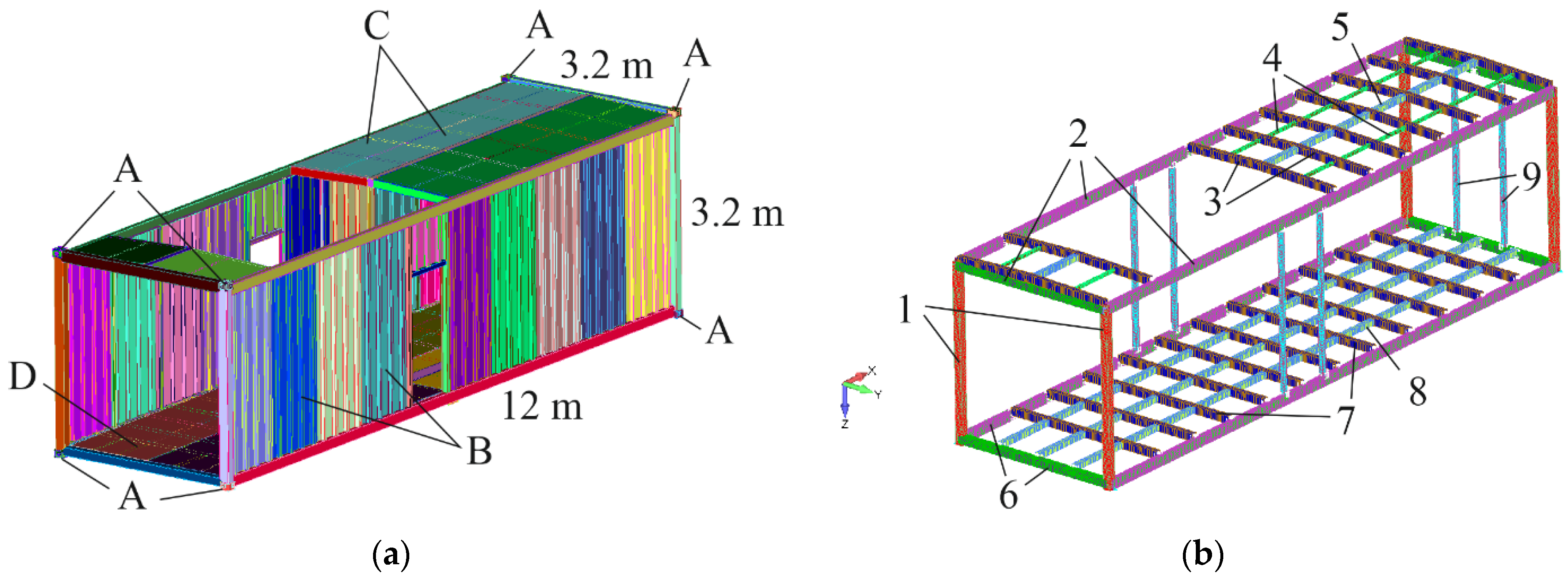
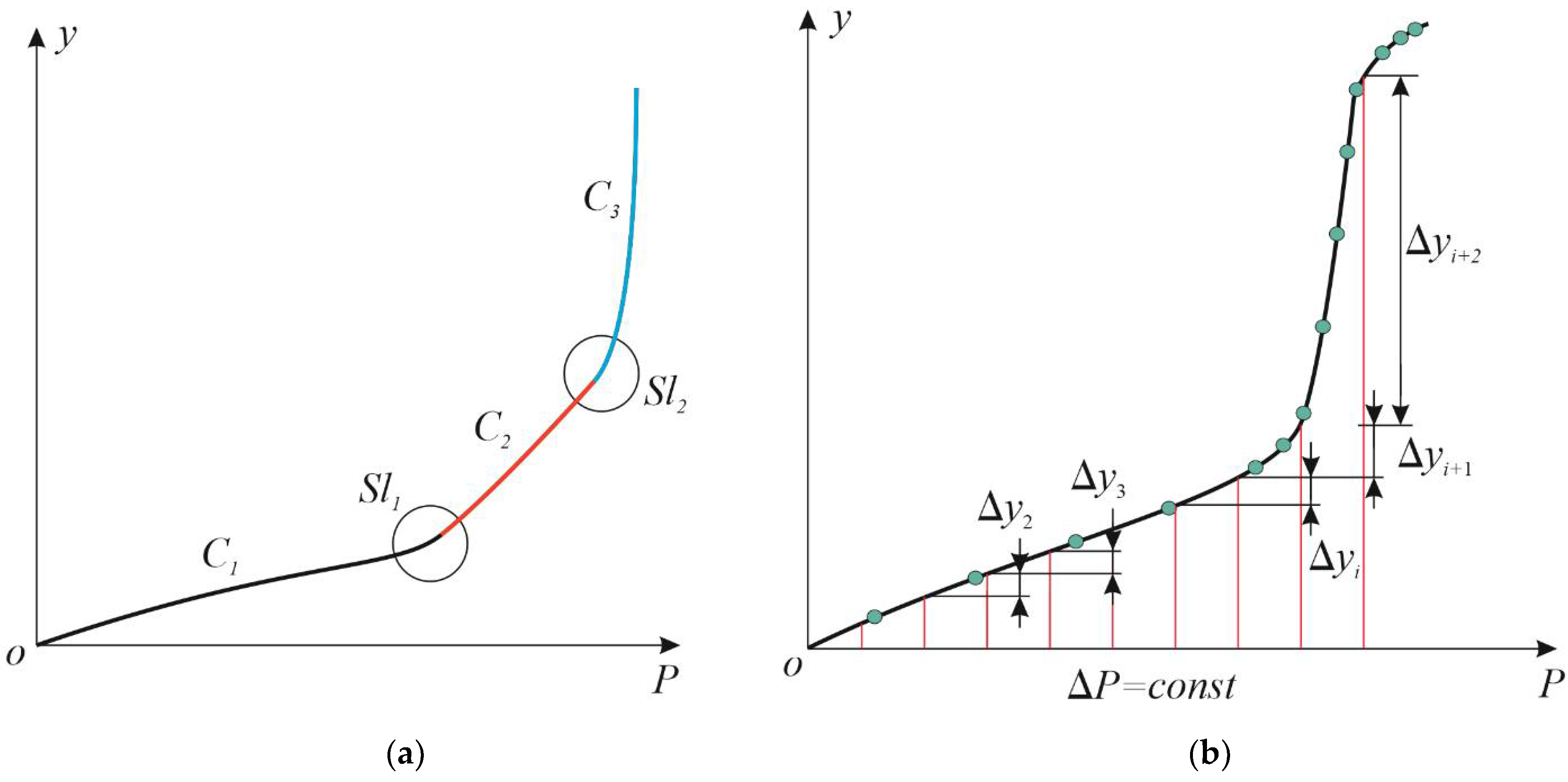


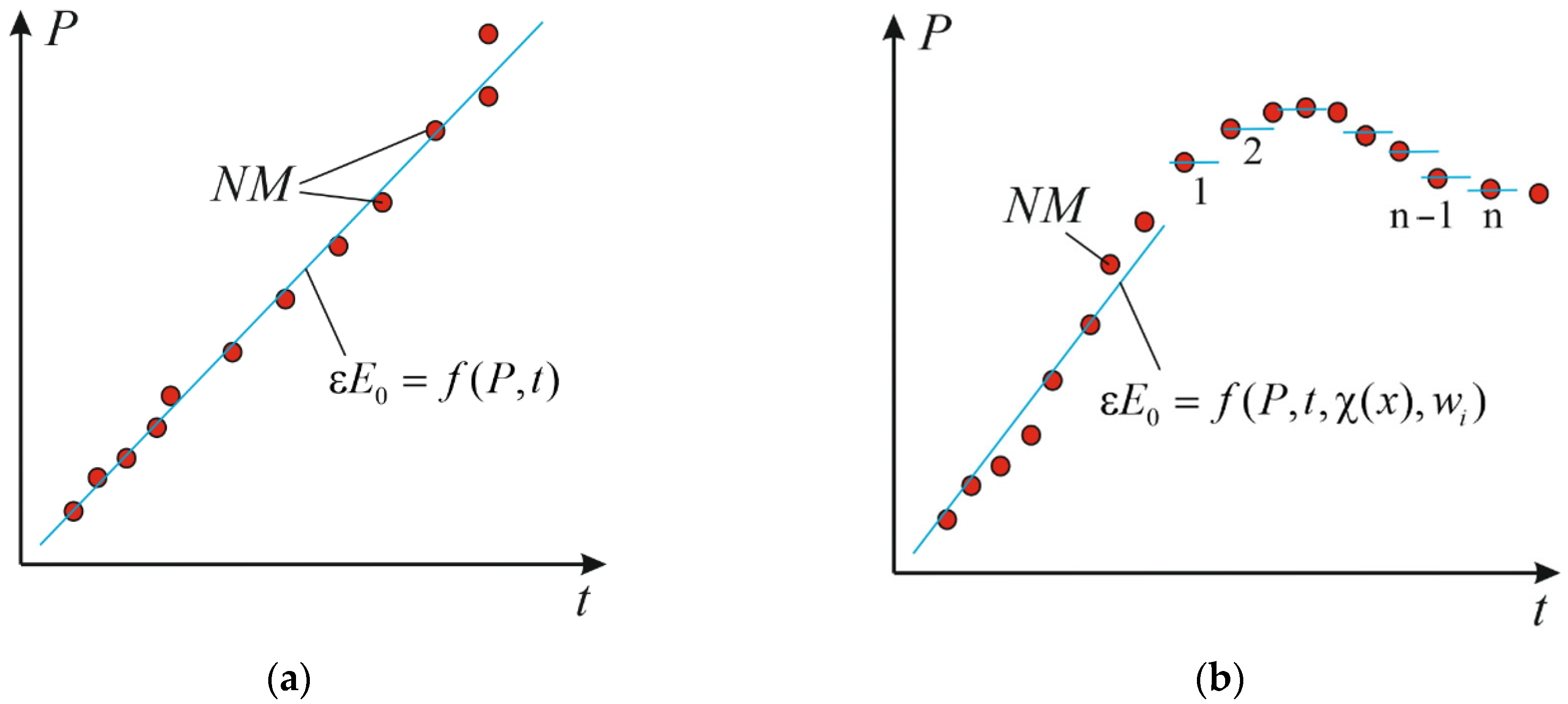
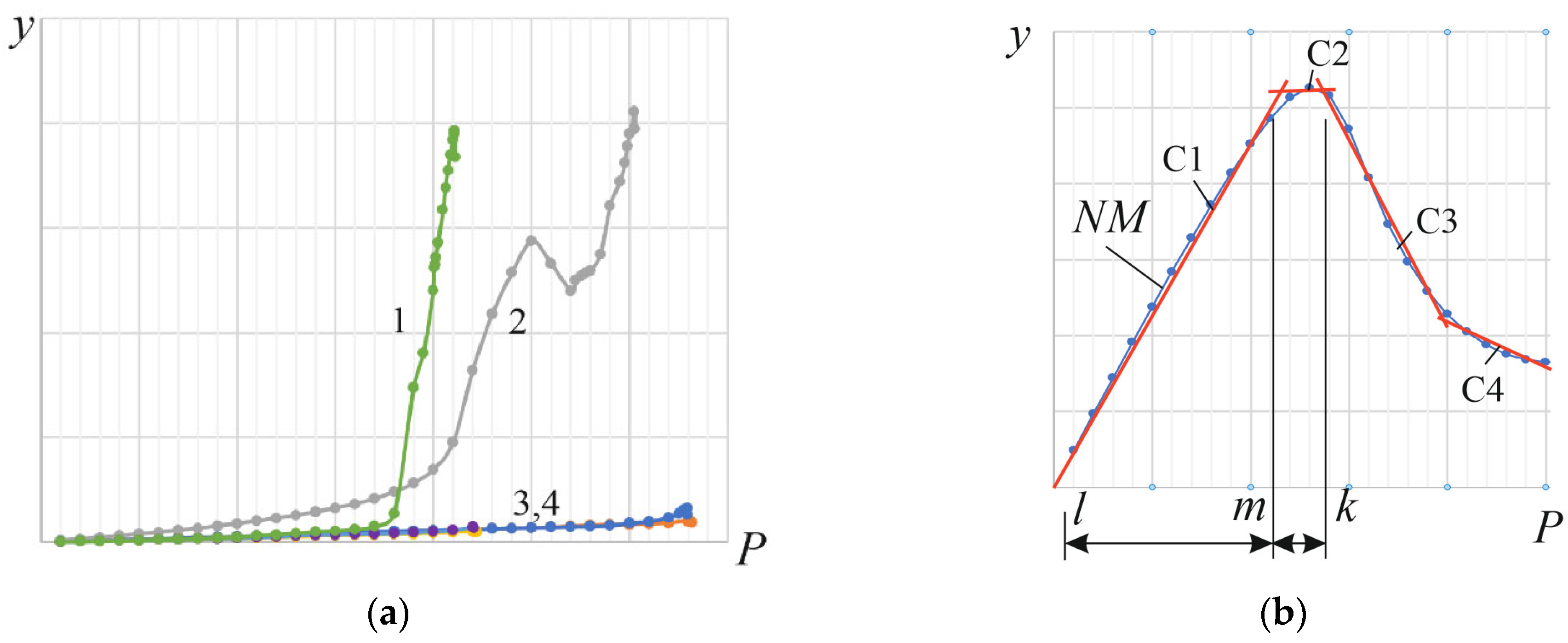
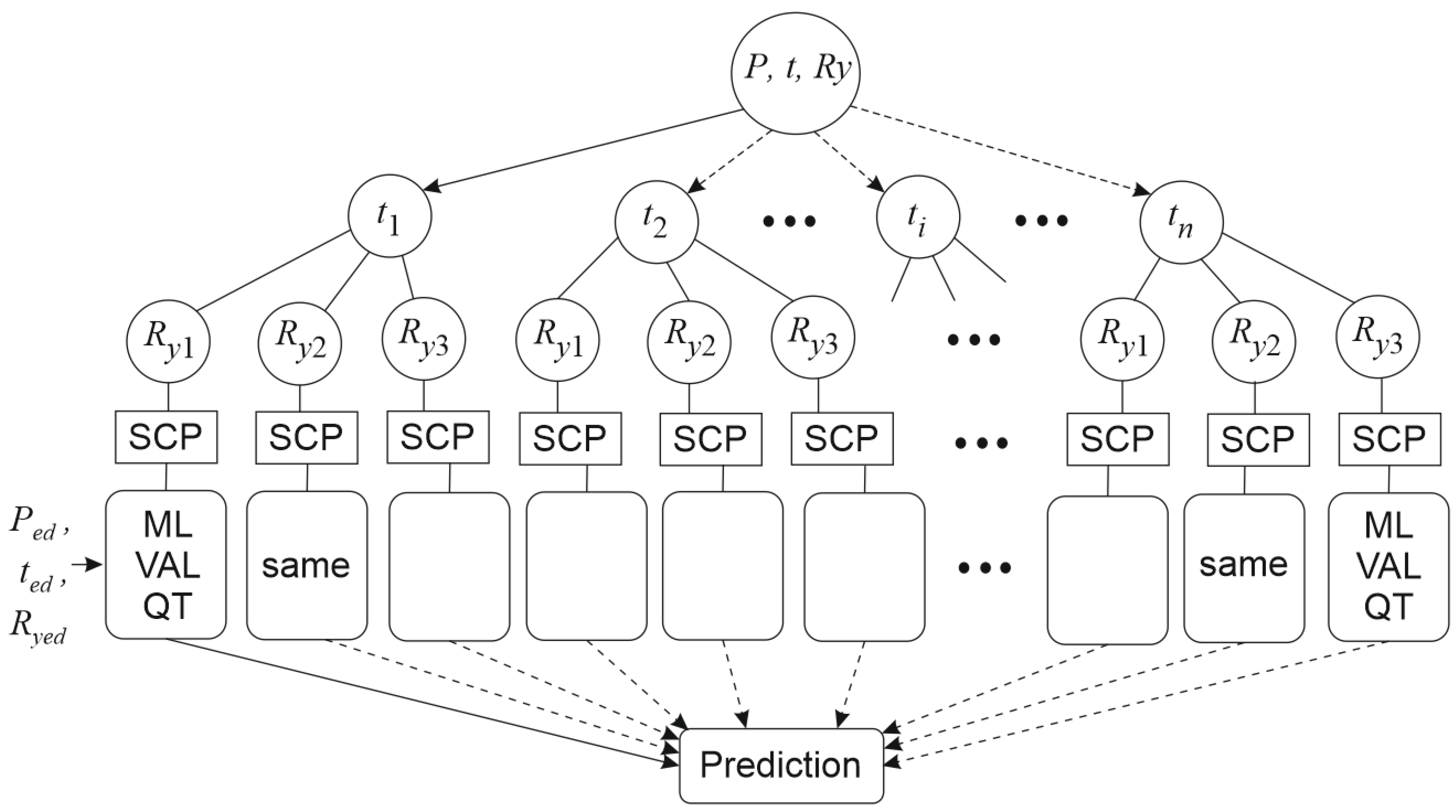
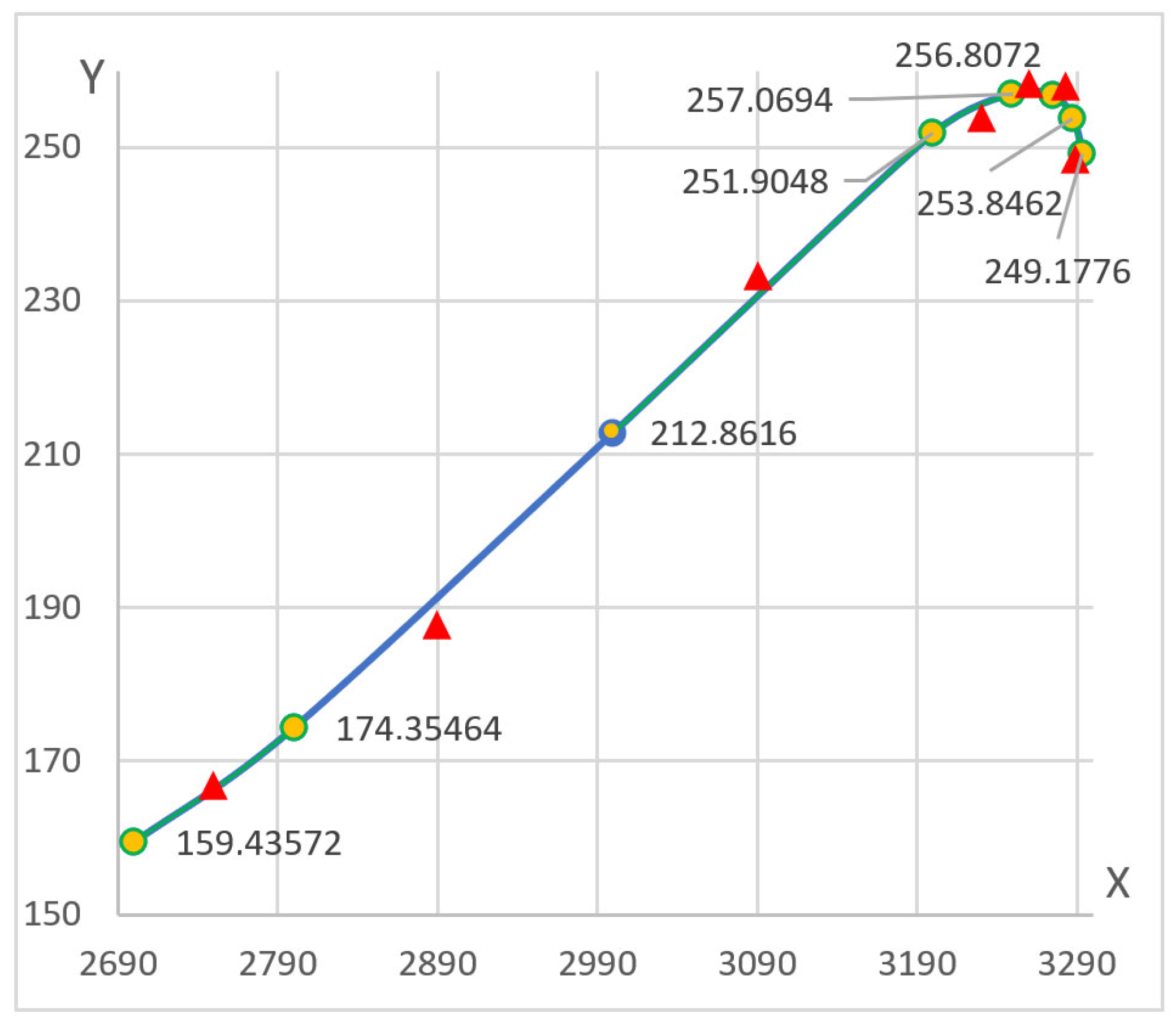
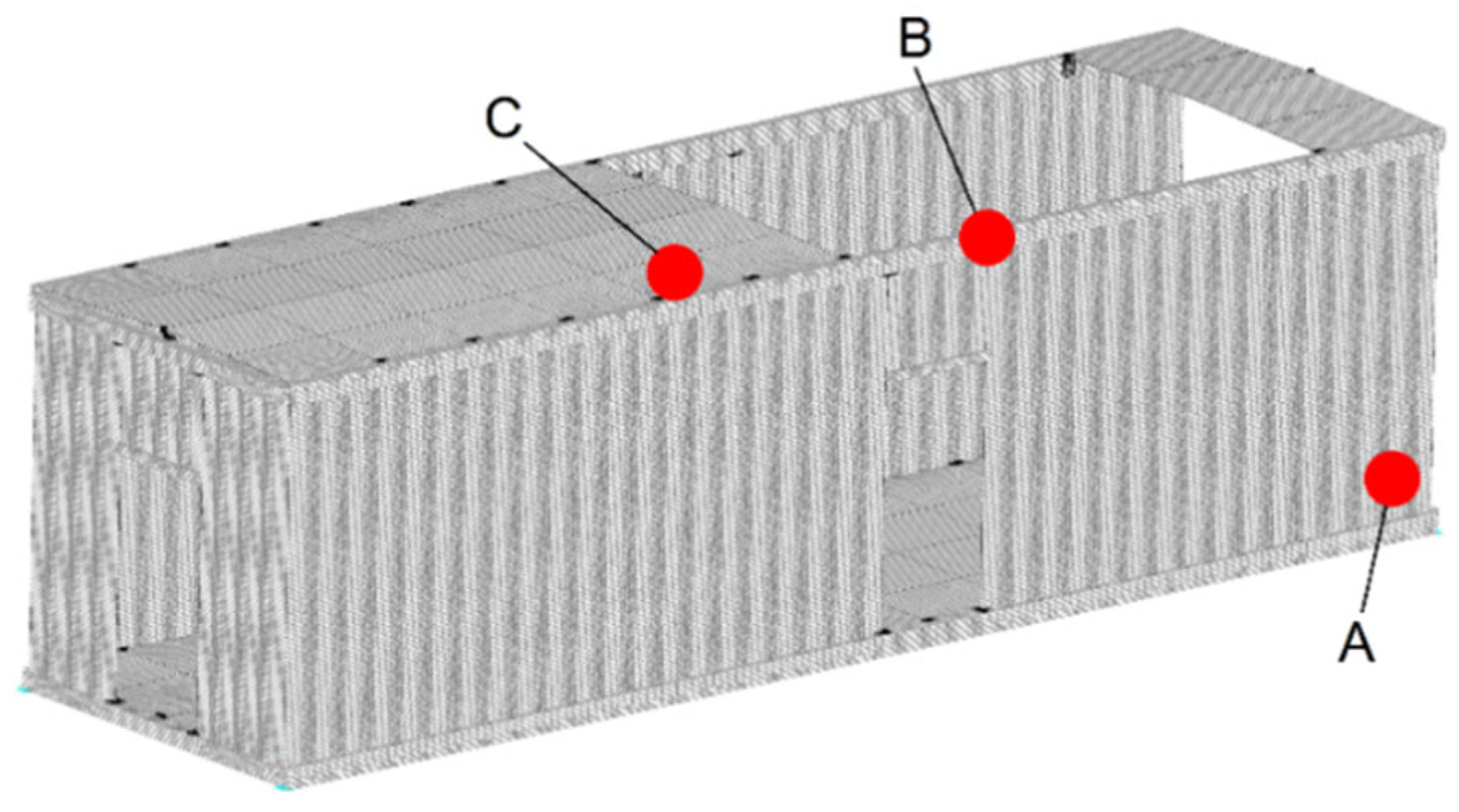


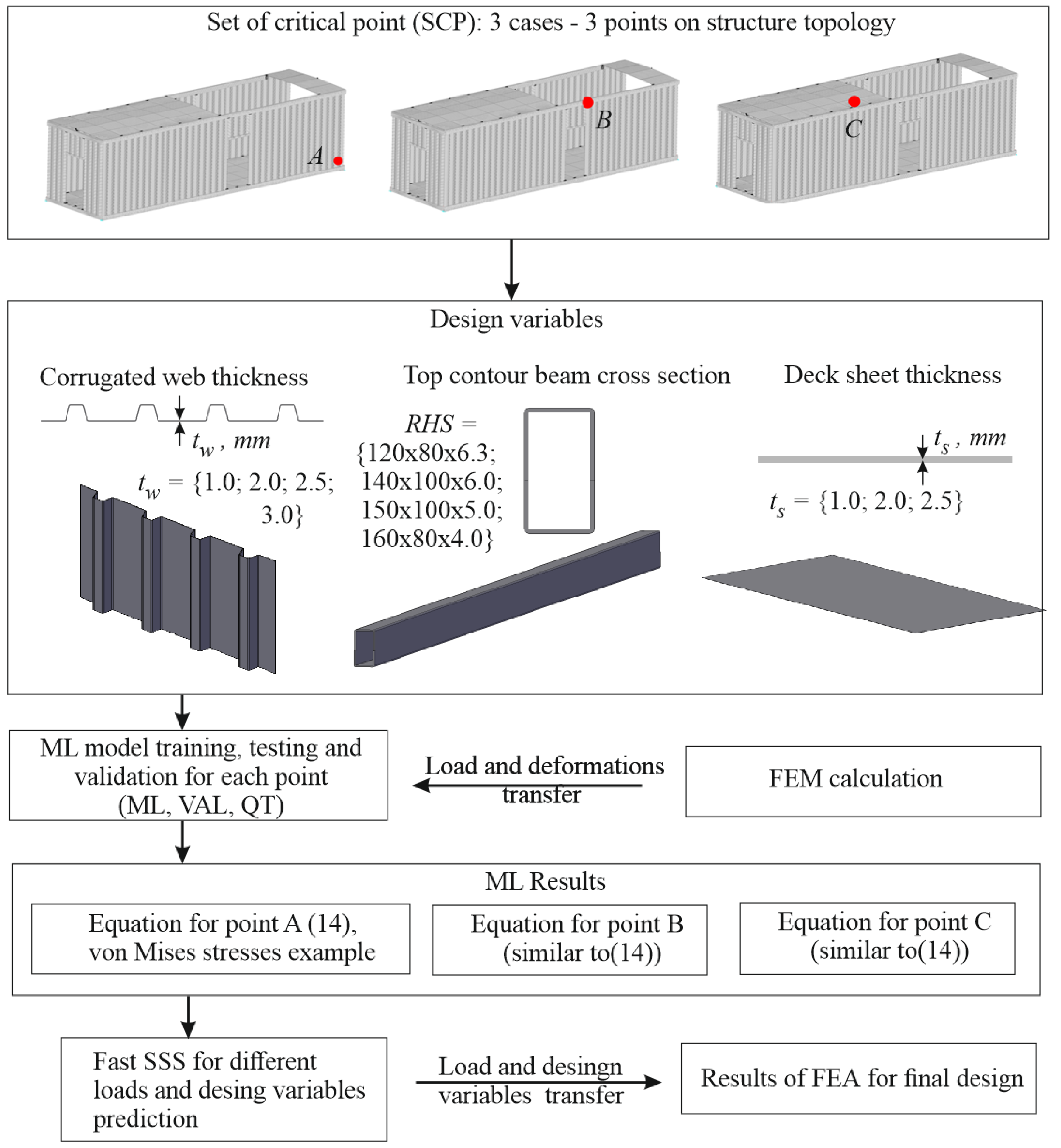
Disclaimer/Publisher’s Note: The statements, opinions and data contained in all publications are solely those of the individual author(s) and contributor(s) and not of MDPI and/or the editor(s). MDPI and/or the editor(s) disclaim responsibility for any injury to people or property resulting from any ideas, methods, instructions or products referred to in the content. |
© 2024 by the authors. Licensee MDPI, Basel, Switzerland. This article is an open access article distributed under the terms and conditions of the Creative Commons Attribution (CC BY) license (https://creativecommons.org/licenses/by/4.0/).
Share and Cite
Tusnin, A.R.; Alekseytsev, A.V.; Tusnina, O. Using Machine Learning Technologies to Design Modular Buildings. Buildings 2024, 14, 2213. https://doi.org/10.3390/buildings14072213
Tusnin AR, Alekseytsev AV, Tusnina O. Using Machine Learning Technologies to Design Modular Buildings. Buildings. 2024; 14(7):2213. https://doi.org/10.3390/buildings14072213
Chicago/Turabian StyleTusnin, Alexander Romanovich, Anatoly Victorovich Alekseytsev, and Olga Tusnina. 2024. "Using Machine Learning Technologies to Design Modular Buildings" Buildings 14, no. 7: 2213. https://doi.org/10.3390/buildings14072213





